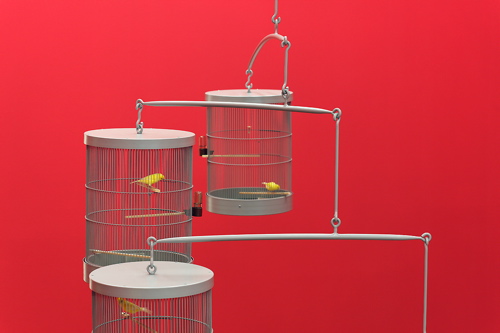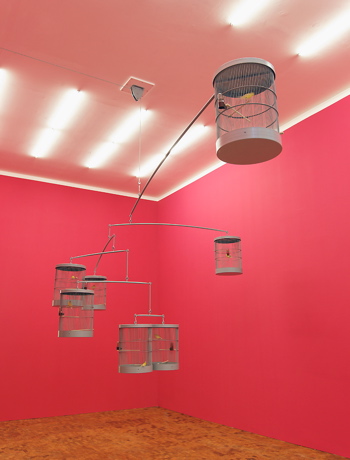POST BY: KAREN ARCHEY

Installation detail of Carsten Höller’s “Vogel Pilz Mathematik” at Esther Schipper. Image via Contemporary Art Daily.
AFC Associate Editor Karen Archey was fortunate enough to spend some time in Berlin during our recent European art tour. This series of reviews reflects a handful of galleries we visited throughout May and June.
Esther Schipper
Linienstrasse 85,
D-10119 Berlin
Carsten Höller, Vogel Pilz Mathematik
I wasn't sure if I was in a zoo, the Ikea kid's section, or a contemporary art space entering Carsten Höller's exhibition, Vogel Pilz Mathematik, at Esther Schipper. Painted mint green and magenta, two of the three galleries paired obnoxious colors with a Doug Aitken-inspired outdoors-meets-design sensibility. As if the 80's-prom-dress-pink paint wasn't enough, Höller festooned the main gallery with a gigantic mobile holding seven round cages, each encasing a canary. Three yellow, black, and white Mondrian-esque paintings hang on an anterior wall of the main gallery while the other two smaller galleries showcase cast toadstool-mushroom hybrids in vitrines and large prints of birds. Although the exhibition impressed more as a high-budget, in-vogue exercise in industrial design, the concept of the show (titled Bird Mushroom Mathematics in English), seems to be the relationship among mathematics, communication, nature and perception. Hung in Höller's version of a Fibonacci sequence, the seven cages spiral out from the mobile's center while the three canvases depict this source formula. Although I've never met a canary with an accent, according to the press release the birds confront the viewer with their “varying dialects,” exploring modes of communication.
After a spin around Esther Schipper—with its perfectly commodifiable, editioned bird prints—my favorite aspect of the exhibition became its off-putting, saccharinely magenta walls. While it may be the most annoying element of the exhibition, it importantly breaks Vogel Pilz Mathematik out of design magazine territory.
If Höller's exhibition confronts modes of communication, why would he aestheticize it in such a vapidly clean, slick manner? Höller undoubtedly puts the “contemporary art cart” before the “concept horse”: the exhibition, resolved too well aesthetically, cannot support his weak mathematic-slash-conceptual structure. What results is in an overly clean exhibition that collapses under its theoretical weight. Given my past experience as a human, I would think these things are a little messy, but maybe it's different for canaries and mushrooms.

Installation view at Esther Schipper. Image via Contemporary Art Daily.


Comments on this entry are closed.